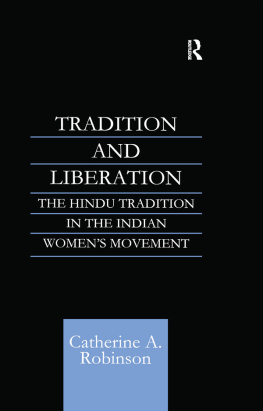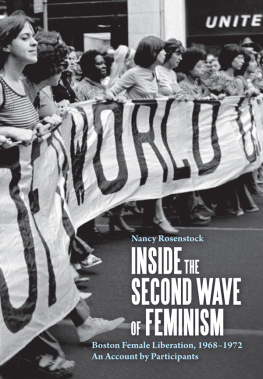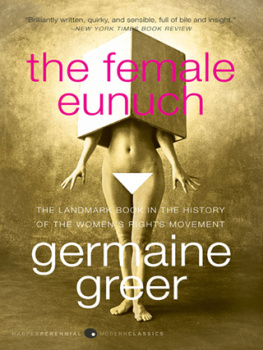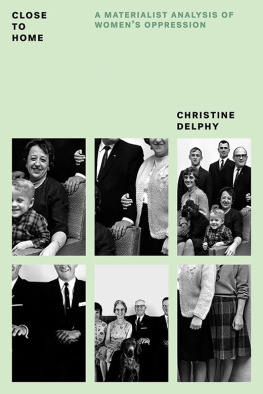ROUTLEDGE LIBRARY EDITIONS:
FEMINIST THEORY
THE LIBERATION OF WOMEN
THE LIBERATION OF WOMEN
A Study of Patriarchy and Capitalism
ROBERTA HAMILTON
Volume 29
First published in 1978
This edition first published in 2013
by Routledge
2 Park Square, Milton Park, Abingdon, Oxon, OX14 4RN
Simultaneously published in the USA and Canada
by Routledge
711 Third Avenue, New York, NY 10017
Routledge is an imprint of the Taylor & Francis Group, an informa business
1978 George Allen & Unwin (Publishers) Ltd
All rights reserved. No part of this book may be reprinted or reproduced or utilised in any form or by any electronic, mechanical, or other means, now known or hereafter invented, including photocopying and recording, or in any information storage or retrieval system, without permission in writing from the publishers.
Trademark notice: Product or corporate names may be trademarks or registered trademarks, and are used only for identification and explanation without intent to infringe.
British Library Cataloguing in Publication Data
A catalogue record for this book is available from the British Library
ISBN: 978-0-415-53401-7 (Set)
eISBN: 978-0-203-08796-1 (Set)
ISBN: 978-0-415-63705-3 (Volume 29)
eISBN: 978-0-203-08483-0 (Volume 29)
Publisher's Note
The publisher has gone to great lengths to ensure the quality of this reprint but points out that some imperfections in the original copies may be apparent.
Disclaimer
The publisher has made every effort to trace copyright holders and would welcome correspondence from those they have been unable to trace.
The
Liberation
of
Women
A Study of
Patriarchy and Capitalism
by
ROBERTA HAMILTON
Concordia University, Montreal
First published in 1978
This book is copyright under the Berne Convention. All rights are reserved. Apart from any fair dealing for the purpose of private study, research, criticism or review, as permitted under the Copyright Act, 1956, no part of this publication may be reproduced, stored in a retrieval system, or transmitted, in any form or by any means, electronic, electrical, chemical, mechanical, optical, photocopying, recording or otherwise, without the prior permission of the copyright owner. Enquiries should be addressed to the publishers.
George Allen & Unwin (Publishers) Ltd, 1978
ISBN 0 04 301085 7 hardback
0 04 301086 5 paperback
Printed in Great Britain by
Biddles Ltd. Guildford. Surrey
Acknowledgements
This book grew out of my intellectual, emotional and political involvement in the Women's Liberation Movement. In that important sense I owe this book, and much more, to the women who preceded me and the women with whom I have shared the experiences of the last few years.
There are also more particular debts. Together, and yet in their very different styles, Professors Hubrt Guindon and Kurt Jonassohn made me believe that this study was worth pursuing. Their enthusiasm, critical support and more tangible sorts of assistance were consistent with what their students have come to expect from these able, committed and kind teachers. I am grateful to Shirley Ciffin and Professor Vivienne Walters for their participation in the development and clarification of my ideas, to Susan Doughty for preparing the typescript with her usual care and precision, and to Tom Bottomore for his encouragement and his helpful editorial suggestions.
Susan Russell has shared my interest in this subject; her parallel research, critical analysis and her emotional and practical support have spared me from any sense of isolation in my work. She is my sister twice over and it is to her that I dedicate this book with love.
Introduction
This inquiry has been provoked by two related questions which, having surfaced periodically for centuries, have been asked more systematically with the development of the Women's Liberation movement in the last decade. First, why have women occupied a subordinate position in society? Second, how can the variations in form and intensity of that subordination be explained?
Within the Women's Liberation movement there have been two different interpretations which have usually been viewed as opposed: a feminist and a Marxist. The feminist analysis has addressed itself to patriarchal ideology, that ideological mode which defines the system of male domination and female subjugation in any society. Like other ideologies, it is instilled through socialisation and maintained by institutional methods (Mitchell, 1971, p. 65). But it differs in one crucial respect. It is predicated on biological differences between the sexes, giving it a materialist basis of its own. The feminists have, therefore, insisted that patriarchal ideology cannot be seen simply as part of the superstructure.
They have a persuasive case. Why not biology? It is the one persistent factor in all cultures, classes, time and space. Citing the time and energy involved in menstruation, pregnancy, childbirth, nursing and child care, Shulamith Firestone concluded that unlike economic class, sex class sprang directly from a biological reality: men and women were created different, and not equal (1970, p. 16). Stories of healthy peasant women giving birth to healthy babies in the fields are largely apocryphal; the high female mortality rate from childbirth throughout history is not. No respector of affluence or power, childbirth was a frequent, inevitable, high-risk activity for women. Periods of dependence after childbirth and low mobility during nursing combined to ensure that women would need to rely on men for a large part of their adult life.
The feminist strategy for overcoming patriarchy stems logically from its analysis. Birth control, abortion and finally test-tube babies will provide the material basis for overcoming the limitations of female biology. The family, once necessary to provide for woman during her periods of dependence, will crumble; men, women and children will love freely; the distinction between affection and eroticism will cease to exist as the need to confine the latter withers away. Furthermore, since all other class and racial antagonisms grew out of, and are reducible to, that initial inequality between men and women, a strike in the marriage beds of the land would be a threat not only to sexism but also to its byproducts racism and the class society (Firestone, 1970, pp. 435, 10321).
It is difficult to imagine an analysis which provides an adequate explanation for the position of women that does not deal with biological differences. All societies make something of menstruation, whether magical, fearful, unclean or debilitating, in addition to the associated physical discomforts which vary from woman to woman. No society until our own has had the technology to control conception. Women have, therefore, had to bring forth children in sorrow, in the words of the Scriptures. Those children have had to be nursed through the first part of the long period of dependence characteristic of human infants. The feminist analysis has located the source of female subordination and male domination in these biological differences between the sexes.











